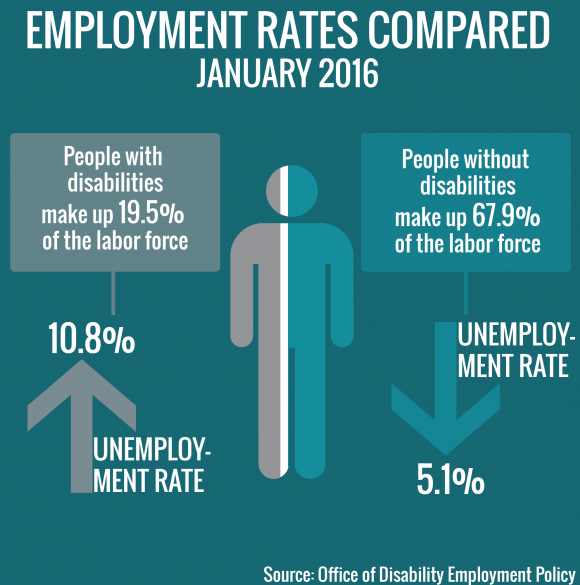Debunking the contradictory employment rates for workers with disabilities
February 24, 2016
Recent figures published by the Office of Disability Employment Policy (ODEP) reflect a seemingly shocking disparity between a 5.1% decrease in the unemployment rate for workers without disabilities and a .5% increase in the same rate for workers with disabilities. Now well this seems initially alarming, it is important to understand how the unemployment rate and the labor force participation rate are measured to fully grasp the issue.
The labor force participation rate is the total amount of people in the work force over the total civilian population of the US. While the unemployment rate is the ratio of those in the work force and looking for work compared to the total amount of people in the work force.
The declining unemployment rate for people without disabilities is mostly attributed to a demographic change. The overall work force is growing slower than the baby boomers who are exiting the work force, which results in a lower unemployment rate. Additionally, some of those seeking work
have become discouraged
and stopped looking for work. By definition these people are no longer a part of the unemployment rate equation, which is reflected by the lower percentage of unemployment.
Infographic by Angie Nguyen, Social Media Assistant for TPI
In July 2015, the
labor force participation rate was 19.8%
compared to the 19.5% measured last month in January 2016. Recalling the definition of labor force participation rate, total population hasn’t decreased since the 1960’s, so the change must be a result of the decreasing total labor force caused by the baby boomers retiring. This is important to note because even though a smaller work force decreased unemployment for people without disabilities, a modest growth of half a percent in unemployment rate was recently cited by the
Office of Disability Employment Policy
.
This increase must mean that there was an increased ready and able workforce raising the unemployment rate against the decreasing overall workforce. The point being, there are people with disabilities looking for jobs and some of them are having a difficult time landing a position.
Even though this increase in the unemployment rate for workers with disabilities seems small, it is important that we continue to monitor these numbers and address the needs in our community. People with disabilities are about
1/3rd as likely
to gain employment compared to those without. The two are different demographics and their respective statistics must be viewed with care.
Thankfully, programs like the ODEP’s
Employment First State Leadership Mentoring Program
(EFSLMP) are driving systematic change behind the belief that “all citizens, including individuals with significant disabilities, are capable of full participation in integrated employment and community life.” It’s programs like this as well as the awareness and activism of everyday citizens that will result in equal employment opportunities for all.
Written by Evan DeVries, Social Media Assistant for TPI


